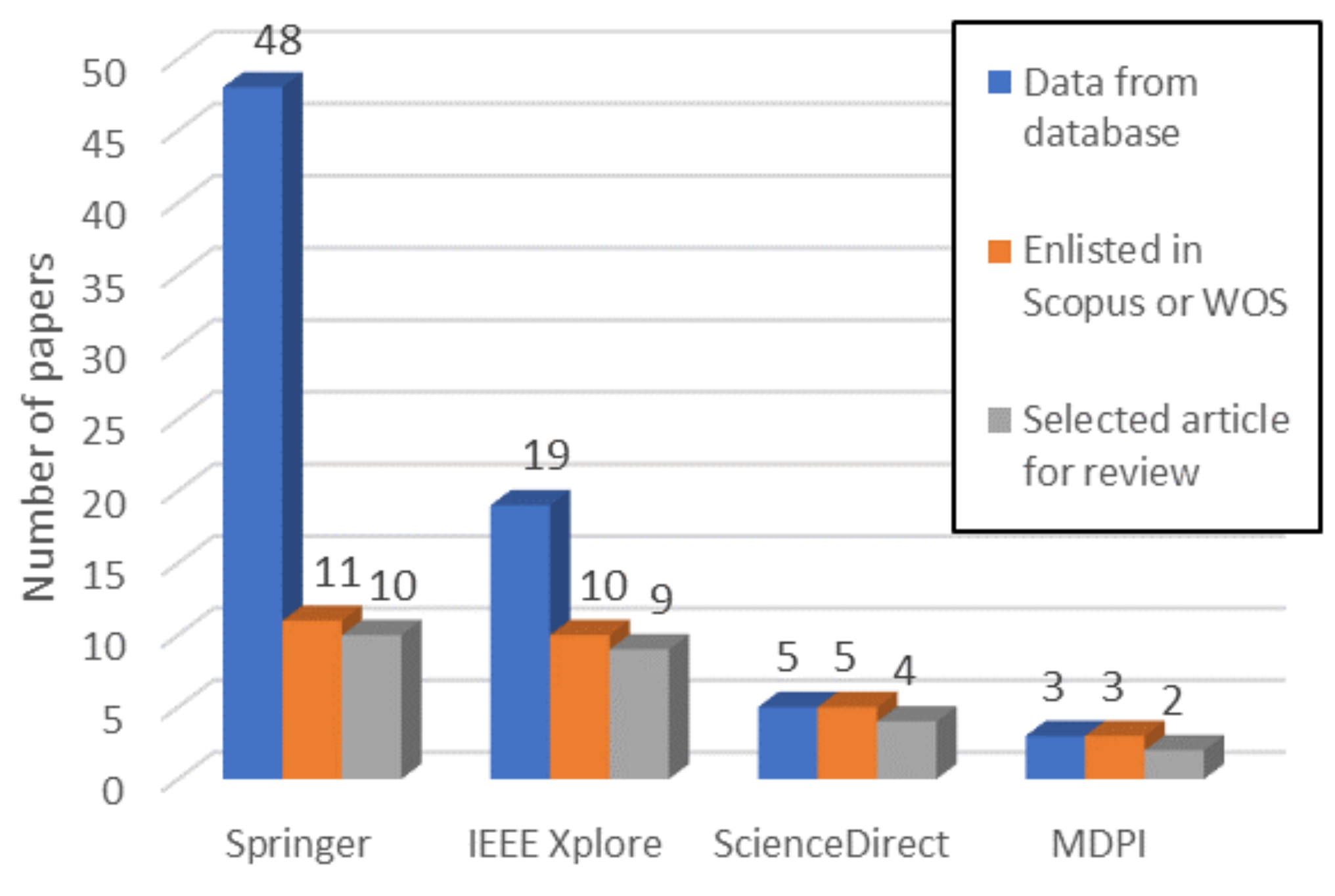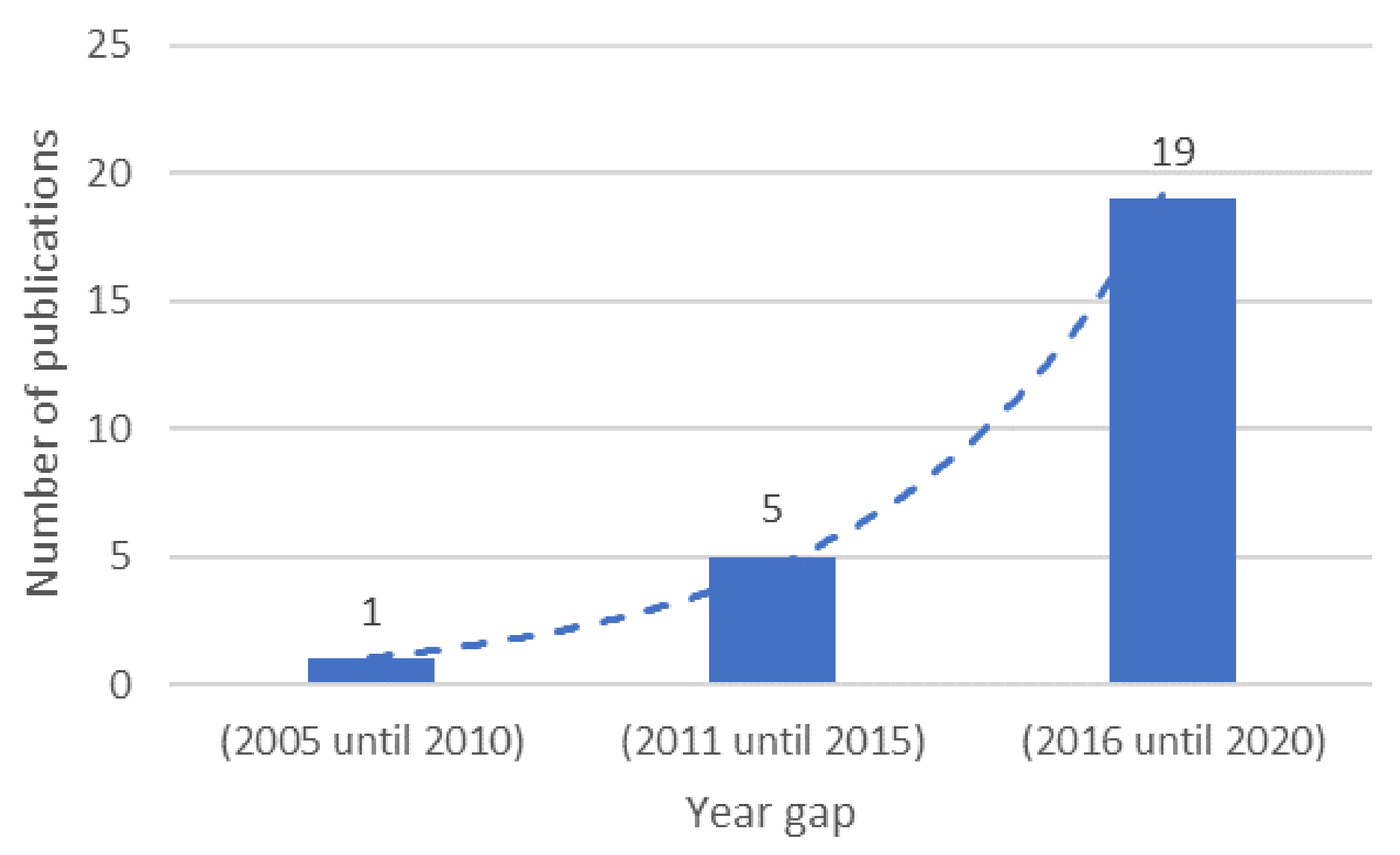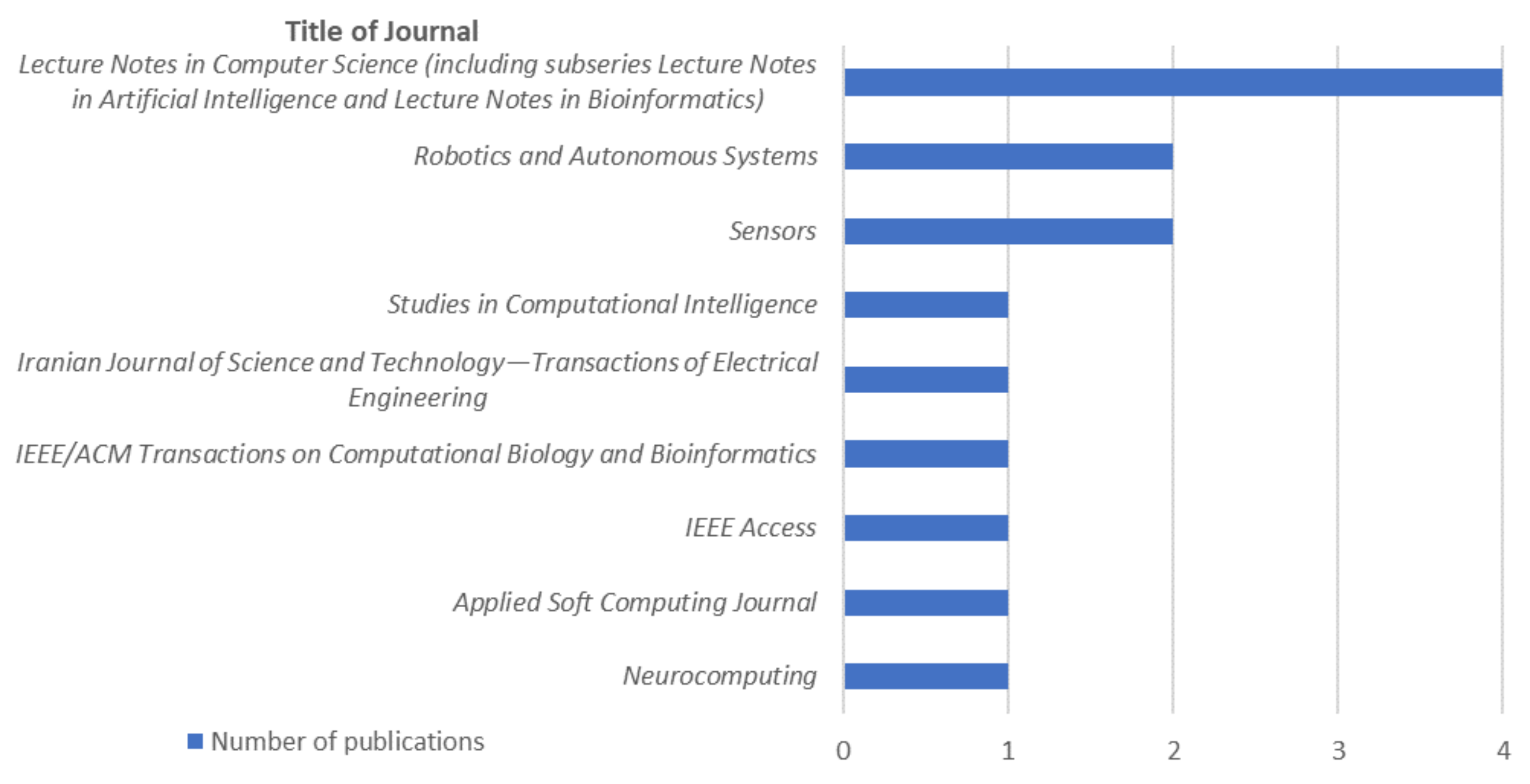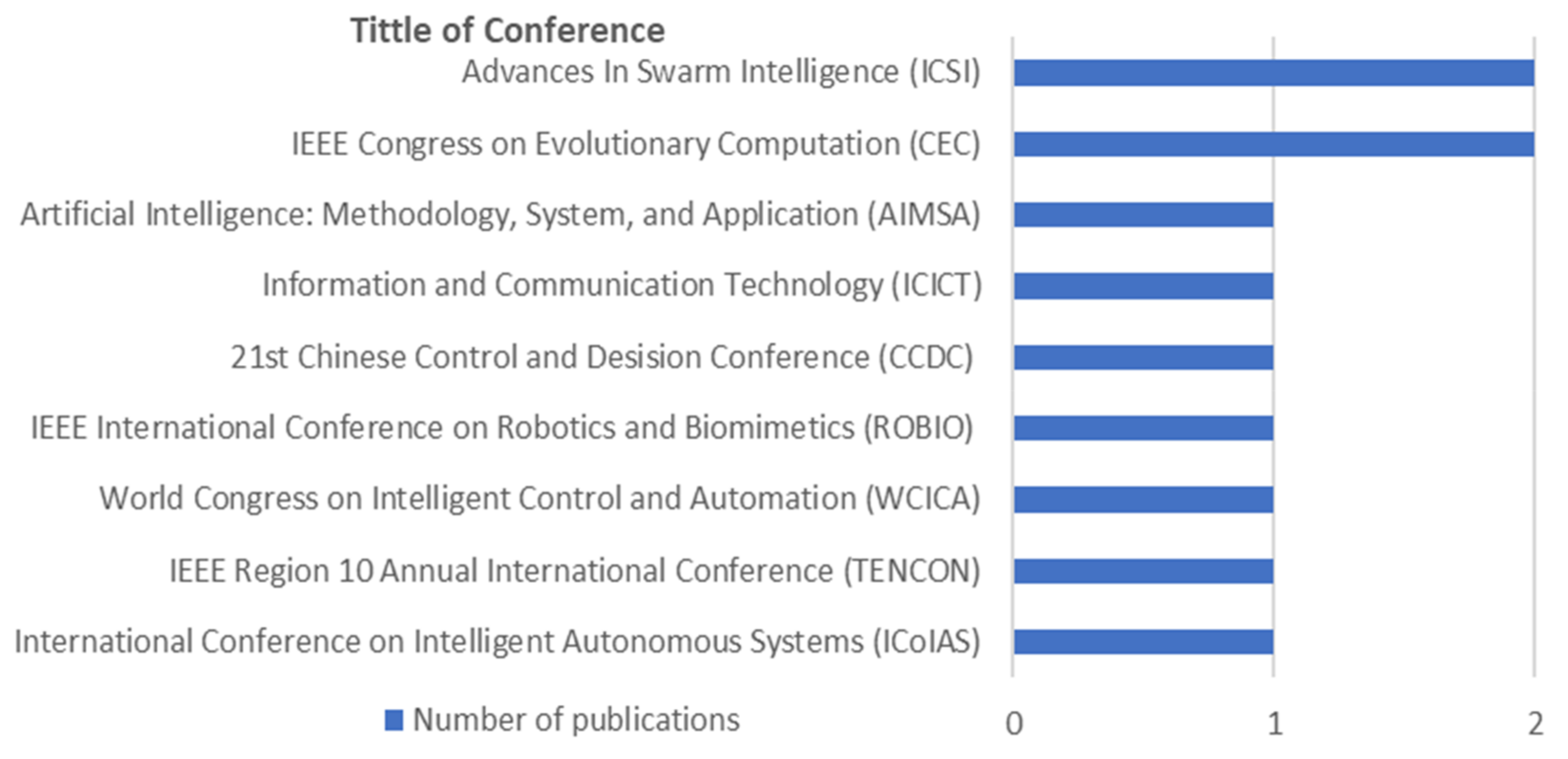Systematic Literature Review of Swarm Robotics Strategies Applied to Target Search Problem with Environment Constraints
Abstract
Featured Application
Abstract
1. Introduction
2. Systematic Literature Review
2.1. Literature Review Planning Protocol
- Research Questions
- 2.
- Databases for Literature Search
- 3.
- Exclusion Criteria
- 4.
- Quality Criterion
- 5.
- Data Extraction Fields
2.2. Execution
3. Background on Swarm Robotics
- The robot swarm must be made up of a number of autonomous robots with the ability to sense and actuate in a real environment;
- The number of robots in the swarm must be large, at least as large as the control rules authorize;
- Robots must be homogenous. There can be different types of robots in the swarm, however, not too varied;
- The robots must not be unable or be inefficient in the main task that they must solve, i.e., they need to cooperate in order to succeed or to improve the performance;
- Robots are limited to local communication and sensing capabilities; this is to ensure the coordination is in distribution mode, so that scalability will become one of the properties of the system.
4. Result of the Systematic Literature Review
4.1. Publication Distribution over the Years
4.2. Publication Distribution among Journals and Conferences
4.3. Citation Analysis
4.4. Research Strategy Analysis
4.4.1. Particle Swarm Optimization
4.4.2. Behavior-Based Approach
4.4.3. Random Walk or RW
4.4.4. Hybrid Strategy
4.4.5. Comparison of SR Strategies Applied to Target Search Problems
5. Conclusions and Future Works
- Derive a mathematical model of the swarm robot interactions and design a suitable controller that comes with a certain proof of convergence [34]. Most of the articles only manually designed the local behaviors, analyzing them by trial and error until the desired swarm behaviors were achieved.
Author Contributions
Funding
Institutional Review Board Statement
Informed Consent Statement
Data Availability Statement
Acknowledgments
Conflicts of Interest
Abbreviations
| ABC | artificial bee colony |
| ACO | ant colony optimization |
| AI | artificial intelligence |
| BA | bees algorithm |
| BFO | bacterial foraging optimization |
| BM | Brownian motion |
| FA | firefly algorithm |
| GES | group explosion strategy |
| GSO | glow-worm swarm optimization |
| IGES | improved group explosion strategy |
| LF | Lévy flight |
| MOPSO | multi-objective particle swarm |
| PSO | particle swarm optimization |
| RbRDPSO | repulsion-based robotic Darwinian particle swarm optimization |
| RDPSO | robotic Darwinian particle swarm optimization |
| RFID | radio frequency identification swarm optimization |
| RPSO | robotic particle swarm optimization |
| RW | random walk |
| SI | swarm intelligence |
| SLR | systematic literature review |
| SR | swarm robotics |
| TFS | triangle formation search |
| VREP | virtual robot experimental platform |
References
- Floreano, D.; Mattiussi, C.; Brooks, R. Bio-Inspired Artificial Intelligence Theories, Methods, and Technologies; The MIT Press: Cambridge, UK, 2000. [Google Scholar]
- Bonabeau, E.; Dorigo, M.; Theraulaz, G. Swarm Intelligence: From Natural to Artificial Systems; Oxford University Press: Oxford, UK, 1999. [Google Scholar]
- Martinoli, A.; Ijspeert, A.; Mondada, F. Understanding collective aggregation mechanisms: From probabilistic modelling to experiments with real robots. Rob. Auton. Syst. 1999, 29, 51–63. [Google Scholar] [CrossRef]
- Sierakowski, C.A.; Coelho, L.D.S. Path Planning Optimization for Mobile Robots Based on Bacteria Colony Approach. In Applied Soft Computing Technologies: The Challenge of Complexity; Springer: Berlin/Heidelberg, Germany, 2006; Volume 34, pp. 187–198. [Google Scholar]
- Zhao, W.; Chu, H.; Zhang, M.; Sun, T.; Guo, L. Flocking control of fixed-wing UAVs with cooperative obstacle avoidance capability. IEEE Access 2019, 7, 17798–17808. [Google Scholar] [CrossRef]
- Ducatelle, F.; Di Caro, G.A.; Pinciroli, C.; Gambardella, L.M. Self-organized cooperation between robotic swarms. Swarm Intell. 2011, 5, 73–96. [Google Scholar] [CrossRef]
- Theraulaz, G.; Bonabeau, E. A brief history of stigmergy. Artif. Life 1999, 5, 97–116. [Google Scholar] [CrossRef] [PubMed]
- Ahmad, F.A.; Ramli, A.R.; Samsudin, K.; Hashim, S.J. Optimization of power utilization in multimobile robot foraging behavior inspired by honeybees system. Sci. World J. 2014, 2014, 1–12. [Google Scholar] [CrossRef] [PubMed][Green Version]
- Mirjalili, S. Dragonfly algorithm: A new meta-heuristic optimization technique for solving single-objective, discrete, and multi-objective problems. Neural Comput. Appl. 2016, 27, 1053–1073. [Google Scholar] [CrossRef]
- Arnold, R.D.; Yamaguchi, H.; Tanaka, T. Search and rescue with autonomous flying robots through behavior-based cooperative intelligence. J. Int. Humanit. Action 2018, 3, 18. [Google Scholar] [CrossRef]
- Shi, H.; Li, J.; Li, Z. A distributed strategy for cooperative autonomous robots using pedestrian behavior for multi-target search in the unknown environment. Sensors 2020, 20, 1606. [Google Scholar] [CrossRef]
- Eberhart, R.; Kennedy, J. A new optimizer using particle swarm theory. In Proceedings of the 6th International Symposium on Micromechatronics and Human Science, Nagoya, Japan, 23–26 November 1999; Volume 0-7803–267, pp. 39–43. [Google Scholar]
- Pham, D.; Ghanbarzadeh, A.; Koç, E.; Otri, S.; Rahim, S.; Zaidi, M. The bees algorithm-A novel tool for complex optimisation problems. Intell. Prod. Mach. Syst. 2006, 454–459. [Google Scholar] [CrossRef]
- Karaboga, D. An Idea Based on Honey Bee Swarm for Numerical Optimization Problems; Springer: New York, NY, USA, 2005. [Google Scholar]
- Dorigo, M.; Di Caro, G.; Gambardella, L.M. Ant algorithms for discrete optimization. Artif. Life 1999, 5, 137–172. [Google Scholar] [CrossRef]
- Dorigo, M.; Gambardella, M.; Birattari, M.; Martinoli, A.; Poli, R.; Stutzle, T. Ant Colony Optimization and Swarm Intelligence, 1st ed.; Springer: Berlin, Germany, 2006; Volume 4150. [Google Scholar]
- Krishnanand, K.; Ghose, D. Detection of multiple source locations using a glowworm metaphor with applications to collective robotics. In Proceedings of the 2005 IEEE Swarm Intelligence Symposium, Pasadena, CA, USA, 8–10 June 2005; pp. 84–91. [Google Scholar] [CrossRef]
- Yang, X. Firefly algorithm. In Nature-Inspired Metaheuristic Algorithms; Luniver Press: Beckington, UK, 2008. [Google Scholar]
- Cardona, G.A.; Calderon, J.M. Robot swarm navigation and victim detection using rendezvous consensus in search and rescue operations. Appl. Sci. 2019, 9, 1702. [Google Scholar] [CrossRef]
- Li, D.; Chen, F.; Wang, Y.; Wang, X. Implementation of a UAV-sensory-system-based hazard source estimation in a chemical plant cluster. In Proceeding of the International Conference on Energy and Environmental Science, Seoul, Korea, 26–29 January 2019; Volume 291, pp. 1–6. [Google Scholar]
- Ma, R.; Li, X.; Sun, M.; Kuang, Z. Experiment of meteorological disaster monitoring on unmanned aerial vehicle. In Proceedings of the 7th International Conference on Agro-geoinformatics (Agro-geoinformatics), Hangzhou, China, 6–9 August 2018; pp. 1–6. [Google Scholar]
- Zheng, Z.; Tan, Y. Group explosion strategy for searching multiple targets using swarm robotic. In Proceedings of the 2013 IEEE Congress on Evolutionary Computation, Cancun, Mexico, 20–23 June 2013; pp. 821–828. [Google Scholar]
- Cai, Y.; Yang, S.X. A potential field-based PSO approach for cooperative target searching of multi-robots. In Proceeding of the 11th World Congress on Intelligent Control and Automation, Shenyang, China, 27–30 June 2014; pp. 1029–1034. [Google Scholar]
- Kitchenham, B. Procedures for performing systematic reviews. Keele Univ. 2004, 33, 1–26. [Google Scholar]
- Beni, G. From Swarm Intelligence to Swarm Robotics. In Lecture Notes in Computer Science; Springer: Berlin/Heidelberg, Germany, 2005; Volume 3342, pp. 1–9. [Google Scholar]
- Bayindir, L.; Şahin, E. A review of studies in swarm robotics. Turk. J. Electr. Eng. Comput. Sci. 2007, 15, 115–147. [Google Scholar]
- Oh, H.; Shirazi, A.R.; Sun, C.; Jin, Y. Bio-inspired self-organising multi-robot pattern formation: A review. Rob. Auton. Syst. 2017, 91, 83–100. [Google Scholar] [CrossRef]
- Senanayake, M.; Senthooran, I.; Barca, J.C.; Chung, H.; Kamruzzaman, J.; Murshed, M. Search and tracking algorithms for swarms of robots: A survey. Robot. Auton. Syst. 2016, 75, 422–434. [Google Scholar] [CrossRef]
- Şahin, E. Swarm Robotics: From Sources of Inspiration to Domains of Application. In Lecture Notes in Computer Science; Springer: Berlin/Heidelberg, Germany, 2005; Volume 3342, pp. 10–20. [Google Scholar]
- Navarro, I.; Matía, F. An Introduction to Swarm Robotics. ISRN Robot. 2012, 2013, 1–10. [Google Scholar] [CrossRef]
- Osaba, E.; Del Ser, J.; Iglesias, A.; Yang, X.-S. Soft Computing for Swarm Robotics: New Trends and Applications. J. Comput. Sci. 2020, 39, 101049. [Google Scholar] [CrossRef]
- Yang, B.; Ding, Y.; Jin, Y.; Hao, K. Self-organized swarm robot for target search and trapping inspired by bacterial chemotaxis. Robot. Auton. Syst. 2015, 72, 83–92. [Google Scholar] [CrossRef]
- Tang, Q.; Yu, F.; Zhang, Y.; Ding, L.; Eberhard, P.; Tan, Y.; Takagi, H.; Shi, Y.; Niu, B. A Stigmergy Based Search Method for Swarm Robots. In Advances in Swarm Intelligence; Springer: Berlin/Heidelberg, Germany, 2017; pp. 199–209. [Google Scholar]
- Li, J.; Tan, Y. The multi-target search problem with environmental restrictions in swarm robotics. In Proceedings of the IEEE International Conference on Robotics and Biomimetics (ROBIO 2014), Bali, Indonesia, 5–10 December 2014; pp. 2685–2690. [Google Scholar]
- Zheng, Z.; Li, J.; Li, J.; Tan, Y. Avoiding decoys in multiple targets searching problems using swarm robotics. In Proceedings of the 2014 IEEE Congress on Evolutionary Computation (CEC), Beijing, China, 6–11 July 2014; pp. 784–791. [Google Scholar]
- Tang, Q.; Ding, L.; Yu, F.; Zhang, Y.; Li, Y.; Tu, H. Swarm Robots Search for Multiple Targets Based on an Improved Grouping Strategy. IEEE/ACM Trans. Comput. Biol. Bioinform. 2017, 15, 1943–1950. [Google Scholar] [CrossRef] [PubMed]
- Yang, B.; Ding, Y.; Hao, K. Target searching and trapping for swarm robots with modified bacterial foraging optimization algorithm. In Proceedings of the 11th World Congress on Intelligent Control and Automation, Shenyang, China, 29 June–4 July 2014; pp. 1348–1353. [Google Scholar]
- Zhong, V.J.; Umamaheshwarappa, R.R.; Dornberger, R.; Hanne, T. Comparison of a Real Kilobot Robot Implementation with its Computer Simulation Focussing on Target-Searching Algorithms. In Proceedings of the 2018 International Conference on Intelligent Autonomous Systems (ICoIAS 2018), Singapore, 1–3 March 2018; pp. 160–164. [Google Scholar]
- Tang, Q.; Zhang, L.; Luo, W.; Ding, L.; Yu, F.; Zhang, J.; Tan, Y.; Shi, Y.; Li, L. A Comparative Study of Biology-Inspired Algorithms Applied to Swarm Robots Target Searching. In Advances in Swarm Intelligence; Springer: Berlin/Heidelberg, Germany, 2016; pp. 479–490. [Google Scholar]
- Li, J.; Tan, Y.; Shi, Y.; Li, L. Triangle Formation Based Multiple Targets Search Using a Swarm of Robots. In Advances in Swarm Intelligence; Springer: Berlin/Heidelberg, Germany, 2016; pp. 544–552. [Google Scholar]
- Songdong, X.; Jianchao, Z.; Jing, D. Target search using swarm robots with kinematic constraints. In Proceedings of the 2009 Chinese Control and Decision Conference, CCDC 2009, Guilin, China, 17–19 June 2009; pp. 3109–3114. [Google Scholar]
- Sinha, M.; Mukhopadhyaya, S. Optimal Tree Search by a Swarm of Mobile Robots. In Information and Communication Technology; Springer: Singapore, 2018; pp. 179–187. [Google Scholar]
- Tang, Q.; Yu, F.; Ding, L.; Tan, Y.; Shi, Y.; Li, L. A Grouping Method for Multiple Targets Search Using Swarm Robots. In Advances in Swarm Intelligence; Springer: Berlin/Heidelberg, Germany, 2016; pp. 470–478. [Google Scholar]
- Fermin, C.K.Y.; Imperial, A.L.L.; Molato, K.F.D.L.; Santos, J.D.A.; Faelden, G.E.U.; Maningo, J.M.Z.; Bandala, A.A. Development and implementation of swarm sweep cleaning protocol for quadrotor unmanned aerial vehicle (QUAV) swarm. In Proceedings of the TENCON 2017—2017 IEEE Region 10 Conference, Penang, Malaysia, 5–8 November 2017; pp. 1988–1991. [Google Scholar]
- Yuen, C.H.; Woo, K.T.; Tan, Y.; Takagi, H.; Shi, Y.; Niu, B. A Survivability Enhanced Swarm Robotic Searching System Using Multi-objective Particle Swarm Optimization. In Advances in Swarm Intelligence; Springer: Berlin/Heidelberg, Germany, 2017; pp. 167–175. [Google Scholar]
- Ouarda, Z.; Nicolas, J.; Hamid, S.; Giancarlo, F. Exploring unknown environments with multi-modal locomotion swarm. In Intelligent Distributed Computing X; Springer: Berlin/Heidelberg, Germany, 2017; pp. 131–140. [Google Scholar]
- Zhong, V.J.; Dornberger, R.; Hanne, T. Comparison of the behavior of swarm robots with their computer simulations applying target-searching algorithms. Int. J. Mech. Eng. Robot. Res. 2018, 7, 507–514. [Google Scholar] [CrossRef]
- Khaluf, Y.; Van Havermaet, S.; Simoens, P. Collective Lévy Walk for Efficient Exploration in Unknown Environments. In Artificial Intelligence: Methodology, Systems, and Applications; Springer: Berlin/Heidelberg, Germany, 2018; pp. 260–264. [Google Scholar]
- Obute, S.O.; Dogar, M.R.; Boyle, J.H. Chemotaxis Based Virtual Fence for Swarm Robots in Unbounded Environments. In Biomimetic and Biohybrid Systems; Springer: Cham, Switzerland, 2019; pp. 216–227. [Google Scholar]
- Li, J.; Tan, Y. A probabilistic finite state machine based strategy for multi-target search using swarm robotics. Appl. Soft Comput. J. 2019, 77, 467–483. [Google Scholar] [CrossRef]
- Li, J.; Tan, Y. A two-stage imitation learning framework for the multi-target search problem in swarm robotics. Neurocomputing 2019, 334, 249–264. [Google Scholar] [CrossRef]
- Tang, Q.; Xu, Z.; Yu, F.; Zhang, Z.; Zhang, J. Dynamic target searching and tracking with swarm robots based on stigmergy mechanism. Robot. Auton. Syst. 2019, 120, 103251. [Google Scholar] [CrossRef]
- Li, G.; Chen, C.; Geng, C.; Li, M.; Xu, H.; Lin, Y. A pheromone-inspired monitoring strategy using a swarm of underwater robots. Sensors 2019, 19, 4089. [Google Scholar] [CrossRef]
- Dadgar, M.; Couceiro, M.S.; Hamzeh, A. RbRDPSO: Repulsion-based RDPSO for robotic target searching. Iran. J. Sci. Technol. Trans. Electr. Eng. 2020, 44, 551–563. [Google Scholar] [CrossRef]
- Zhang, X.; Ali, M. A Bean Optimization-Based Cooperation Method for Target Searching by Swarm UAVs in Unknown Environments. IEEE Access 2020, 8, 43850–43862. [Google Scholar] [CrossRef]
- Kennedy, J.; Eberhart, R.C. A discrete binary version of the particle swarm algorithm. In Proceedings of the IEEE International Conference on Systems, Man, and Cybernetics. Computational Cybernetics and Simulation, Orlando, FL, USA, 12–15 October 1997; Volume 5, pp. 4104–4108. [Google Scholar]
- Shi, Y.; Eberhart, R. A Modified Particle Swarm Optimizer. In Proceedings of the IEEE International Conference on Evolutionary Computation Proceedings, Anchorage, AK, USA, 4–9 May 1998; pp. 69–73. [Google Scholar]
- Balch, T.; Arkin, R. Behavior-based formation control for multirobot teams. IEEE Trans. Robot. Autom. 1998, 14, 926–939. [Google Scholar] [CrossRef]
- Pang, B.; Song, Y.; Zhang, C.; Wang, H.; Yang, R. A swarm robotic exploration strategy based on an improved random walk method. J. Robot. 2019, 2019, 1–9. [Google Scholar] [CrossRef]
- Einstein, A. Über die von der molekularkinetischen Theorie der Wärme geforderte Bewegung von in ruhenden Flüssigkeiten suspendierten Teilchen. Ann. Phys. 1905, 322, 549–560. [Google Scholar] [CrossRef]
- Zaburdaev, V.; Denisov, S.; Klafter, J. Lévy walks. Rev. Mod. Phys. 2015, 87, 483–530. [Google Scholar] [CrossRef]
- Zheng, Z.; Li, J.; Li, J.; Tan, Y. Improved group explosion strategy for searching multiple targets using swarm robotics. In Proceedings of the 2014 IEEE International Conference on Systems, Man, and Cybernetics (SMC), San Diego, CA, USA, 5–8 October 2014; pp. 246–251. [Google Scholar]





| Title | Publication Year | Citations |
|---|---|---|
| Self-organized swarm robots for target search and trapping inspired by Bacterial Chemotaxis [32] | 2015 | 33 |
| Group explosion strategy for searching multiple targets using swarm robotic [22] | 2013 | 17 |
| A stigmergy based search method for swarm robots [33] | 2017 | 8 |
| The multi-target search problem with environmental restrictions in swarm robotics [34] | 2014 | 7 |
| Avoiding decoys in multiple targets searching problems using swarm robotics [35] | 2014 | 6 |
| Swarm robots search for multiple targets based on an improved grouping strategy [36] | 2018 | 4 |
| Target searching and trapping for swarm robots with modified bacterial foraging optimization algorithm [37] | 2015 | 4 |
| Comparison of a real Kilobot robot implementation with its computer simulation focusing on target-searching algorithms [38] | 2018 | 3 |
| A comparative study of biology-inspired algorithms applied to swarm robots target searching [39] | 2016 | 2 |
| Triangle formation based multiple targets search using a swarm of robots [40] | 2016 | 2 |
| Target search using swarm robots with kinematic constraints [41] | 2009 | 2 |
| Optimal tree search by a swarm of mobile robots [42] | 2018 | 1 |
| A grouping method for multiple targets search using swarm robots [43] | 2016 | 1 |
| Reference | SR Proposed Method | Number of Target(s) | Targets/Agents Ratio | Mobility of Targets | Environment Complexity | Verification Method | Inspiration Phenomenon |
|---|---|---|---|---|---|---|---|
| [41] | Kinematic constrain target search strategy | Single | <1 | Static | Empty space | Simulation | Flocking behavior of birds |
| [22] | Group explosion strategy (GES) | Multiple | >1 | Static | Empty space | Simulation | Explosion phenomenon in nature |
| [34] | Three restriction-handling strategies | Multiple | <1 | Static | Cluttered | Simulation | Explosion phenomenon in nature and flocking behavior of birds |
| [35] | Decoy-avoiding strategies | Multiple | <1 | Static | Cluttered | Simulation | Explosion phenomenon in nature and flocking behavior of birds |
| [37] | Modified bacterial foraging optimization (MBFO) strategy | Multiple | <1 | Static | Cluttered | Simulation | Foraging behavior of bacteria (Escherichia coli) |
| [32] | Self-organized target search and trapping strategy | Multiple | <1 | Dynamic | Empty space | Simulation | Foraging behavior of bacteria (Escherichia coli) |
| [43] | Integrated strategy based on a modified particle swarm optimization (PSO) algorithm and a grouping strategy | Multiple | <1 | Static | Empty space | Simulation | Flocking behavior of birds |
| [39] | Comparative between PSO, ant colony optimization (ACO) and genetic algorithm (GA) in target search | Single | <1 | Static | Cluttered | Simulation | Flocking behavior of birds, foraging behavior of ants, and natural selection by biologically inspired selection |
| [40] | Triangle formation search (TFS) strategy | Multiple | <1 | Static | Empty space | Simulation | Triangle formation behavior |
| [44] | Sweep cleaning protocol strategy | Single | <1 | Dynamic | Empty space | Simulation | Sweep cleaning behavior |
| [33] | Finite-state machine and coding phase pheromone strategy | Single | <1 | Static | Empty space | Simulation and real robot | Cockroach behavior |
| [45] | Multi-objective particle swarm optimization (MOPSO) and energy-saving decision rules strategy | Single | <1 | Static | Empty space | Simulation | Flocking behavior of birds |
| [46] | Flying ant-like search strategy | Multiple | <1 | Static | Cluttered | Simulation | Flying ant behavior |
| [36] | Improved grouping strategy based on constriction factor particle swarm optimization (CFPSO) | Multiple | <1 | Static | Cluttered | Simulation | Flocking behavior of birds |
| [47] | Dispersal search strategy | Single | <1 | Static | Empty space | Simulation and real robot | Random walk behavior |
| [42] | Tree search strategy | Single | <1 | Static | Cluttered | Simulation | Tree target searching behavior |
| [48] | Lévy walk strategy | Multiple | <1 | Static | Empty space | Simulation | Lévy flight behavior |
| [49] | Chemotaxis behavior strategy | Single | <1 | Dynamic | Cluttered | Simulation and real robot | Microorganism behavior |
| [50] | A probabilistic finite state machine-based strategy | Multiple | <1 | Static | Empty space | Simulation | Random walk and triangle estimation technology |
| [51] | A two-stage imitation learning framework strategy | Multiple | <1 | Static | Empty space | Simulation | Deep learning and evolutionary algorithm. |
| [52] | Dynamic target searching and tracking stigmergy strategy | Single | <1 | Dynamic | Empty space | Simulation and real robot | Foraging behavior of ant |
| [53] | A pheromone underwater robot monitoring strategy | Multiple | <1 | Static | Empty space | Simulation and real robot | Foraging behavior of ant |
| [54] | Repulsion-based robotic Darwinian particle swarm optimization (RDPSO) strategy | Single | <1 | Static | Cluttered | Simulation | Flocking behavior of birds |
| [55] | Bean optimization-based cooperation strategy | Single | <1 | Static | Empty space | Simulation | Natural plant evolution behavior |
| [11] | A distributed strategy for multi-target search in an unknown environment strategy | Multiple | <1 | Static | Empty space | Simulation | Pedestrian behavior |
| SR Strategies | Mechanism | Advantages | Limitation |
|---|---|---|---|
| Particle Swarm Optimization |
|
|
|
| Behavior-based |
| The flexibility of its input sensor combination enable the behavior-based strategy to comply with several search environment scenarios. |
|
| Random Walk |
|
| The random walk distribution and its properties tend to be lost when the swarm size increases. |
| Hybrid Strategy | Combining two or more SR strategies to overcome the limitation of each strategy. | Dependent on the combined strategies that have been implemented. | Dependent on the combined strategies that have been implemented. |
Publisher’s Note: MDPI stays neutral with regard to jurisdictional claims in published maps and institutional affiliations. |
© 2021 by the authors. Licensee MDPI, Basel, Switzerland. This article is an open access article distributed under the terms and conditions of the Creative Commons Attribution (CC BY) license (http://creativecommons.org/licenses/by/4.0/).
Share and Cite
Ismail, Z.H.; Hamami, M.G.M. Systematic Literature Review of Swarm Robotics Strategies Applied to Target Search Problem with Environment Constraints. Appl. Sci. 2021, 11, 2383. https://doi.org/10.3390/app11052383
Ismail ZH, Hamami MGM. Systematic Literature Review of Swarm Robotics Strategies Applied to Target Search Problem with Environment Constraints. Applied Sciences. 2021; 11(5):2383. https://doi.org/10.3390/app11052383
Chicago/Turabian StyleIsmail, Zool Hilmi, and Mohd Ghazali Mohd Hamami. 2021. "Systematic Literature Review of Swarm Robotics Strategies Applied to Target Search Problem with Environment Constraints" Applied Sciences 11, no. 5: 2383. https://doi.org/10.3390/app11052383
APA StyleIsmail, Z. H., & Hamami, M. G. M. (2021). Systematic Literature Review of Swarm Robotics Strategies Applied to Target Search Problem with Environment Constraints. Applied Sciences, 11(5), 2383. https://doi.org/10.3390/app11052383







